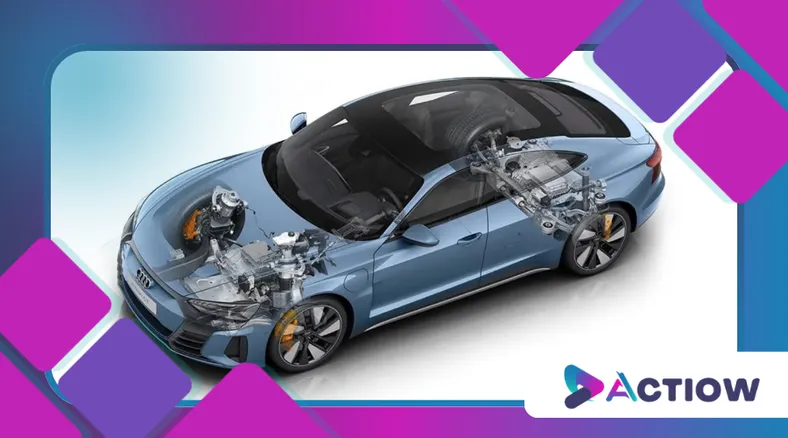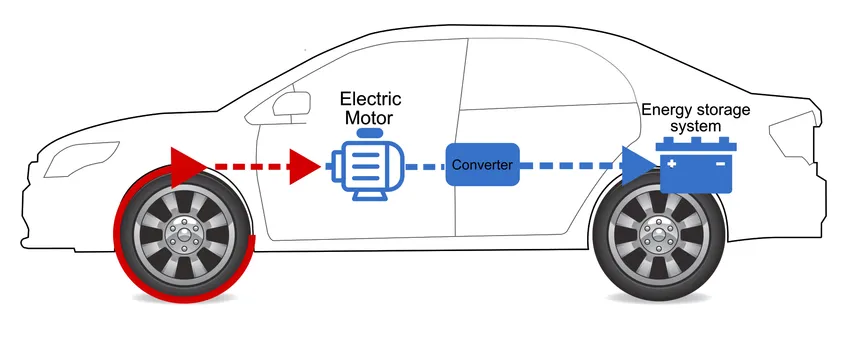How Regenerative Braking Works in Electric Cars

Anúncios
Electric vehicles (EVs) are revolutionizing the automotive industry, and one of the most innovative features driving this change is how Braking Works in Electric Cars.
Unlike traditional vehicles, EVs harness cutting-edge technology to convert kinetic energy into electricity, enhancing efficiency and sustainability.
This process, known as regenerative braking, is not just a futuristic concept—it’s a reality shaping the way we drive today.
Anúncios
As consumer awareness about environmental issues grows, the demand for energy-efficient technologies like regenerative braking is expected to rise.
This shift is not only beneficial for the planet but also for drivers looking to reduce their fuel costs and maintenance expenses.
The Science Behind Regenerative Braking
At its core, regenerative braking is a system that captures energy typically lost during deceleration.
When you press the brake pedal in an electric car, the electric motor reverses its function.
Instead of consuming electricity to propel the vehicle, it acts as a generator, converting the car’s motion into electrical energy.
This energy is then stored in the battery, ready to be reused.
Traditional braking systems rely on friction to slow down a vehicle, which generates heat and wears down brake pads.
In contrast, regenerative braking minimizes this wear and tear, offering a dual benefit: extended brake life and improved energy efficiency.
According to a study by the U.S. Department of Energy, regenerative braking can improve an EV’s efficiency by up to 20%, depending on driving conditions.
Moreover, as battery technology improves, the amount of energy that can be captured and reused through regenerative braking is likely to increase, further enhancing overall vehicle efficiency.
This continuous improvement in energy management is crucial as the automotive industry pushes toward more sustainable practices.
+ Self-Driving Cars: Has the Future of Mobility Arrived?
How Braking Works in Electric Cars: A Step-by-Step Breakdown
- Deceleration Initiation: When the driver lifts their foot off the accelerator or presses the brake pedal, the system detects the need to slow down.
- Motor Reversal: The electric motor switches to generator mode, using the vehicle’s momentum to produce electricity.
- Energy Conversion: The kinetic energy is converted into electrical energy, which is then fed back into the battery.
- Vehicle Slowdown: The process creates resistance, slowing the car without relying solely on mechanical brakes.
This seamless integration of technology ensures a smoother driving experience while maximizing energy recovery.
Additionally, the effectiveness of regenerative braking can vary based on driving conditions, such as terrain and weather.
For instance, driving downhill allows for greater energy recovery, while stop-and-go traffic can lead to frequent energy capture opportunities.
Understanding these dynamics can help drivers optimize their use of regenerative braking for better efficiency.
The Role of Software in Optimizing Braking Systems
Modern EVs are equipped with advanced software that fine-tunes the regenerative braking process.
These systems adjust the level of regenerative force based on factors like battery charge, driving speed, and road conditions.
For instance, in stop-and-go traffic, the system might prioritize energy recovery, while on highways, it could focus on maintaining speed and stability.
Tesla, for example, offers drivers the ability to customize regenerative braking settings.
This level of control not only enhances efficiency but also allows drivers to adapt the system to their preferences.
Moreover, as software continues to evolve, we can expect even more sophisticated algorithms that learn from driving habits and improve energy recovery over time.
This personalized approach not only enhances the driving experience but also contributes to overall energy savings.

Comparing Regenerative and Traditional Braking Systems
| Aspect | Regenerative Braking | Traditional Braking |
|---|---|---|
| Energy Efficiency | Converts kinetic energy to electricity | Wastes energy as heat |
| Brake Wear | Reduces wear on brake components | Causes gradual wear and tear |
| Environmental Impact | Lowers emissions by reusing energy | Increases particulate pollution |
As the table illustrates, regenerative braking offers significant advantages over conventional systems, making it a cornerstone of EV design.
Additionally, the reduced reliance on mechanical brakes means that the overall maintenance costs for electric vehicles can be lower over time.
This long-term cost-effectiveness is appealing not only to individual drivers but also to fleet operators looking to optimize expenses.
++ Cars with Facial Recognition: Technology at the Service of Safety
Real-World Applications and Benefits
The impact of regenerative braking extends beyond individual drivers.
Cities with high EV adoption rates, such as Oslo and Amsterdam, have reported reduced air pollution levels, partly due to the efficiency of these systems.
Additionally, fleet operators, including delivery services and ride-sharing companies, are seeing lower maintenance costs and extended vehicle lifespans.
For everyday drivers, the benefits are equally compelling.
Imagine driving through a hilly area—regenerative braking ensures that the energy used to climb is partially recovered during descent.
This not only extends the driving range but also reduces the frequency of charging stops.
Furthermore, as more cities implement infrastructure to support electric vehicles, the benefits of regenerative braking will become even more pronounced.
Charging stations equipped with fast-charging capabilities can further enhance the efficiency of EVs, allowing for quicker turnarounds and less downtime.

Challenges and Limitations
While regenerative braking is a game-changer, it’s not without its challenges.
One limitation is its reduced effectiveness at high speeds or during sudden stops, where mechanical brakes are still necessary.
Additionally, in colder climates, battery efficiency drops, which can impact the system’s performance.
However, automakers are continuously innovating to address these issues.
For example, some EVs now feature blended braking systems that seamlessly integrate regenerative and mechanical braking, ensuring optimal performance in all conditions.
Moreover, ongoing research into battery technology aims to improve performance in various weather conditions, making regenerative braking even more reliable.
By tackling these challenges, the automotive industry can further enhance the practicality and effectiveness of regenerative braking systems.
The Future of Braking Systems in Electric Cars
As EV technology evolves, so too will regenerative braking.
Researchers are exploring ways to enhance energy recovery, such as incorporating supercapacitors to store energy more efficiently.
Moreover, advancements in artificial intelligence could lead to smarter braking systems that predict driving patterns and optimize energy usage in real-time.
The integration of vehicle-to-grid (V2G) technology also holds promise.
In the near future, EVs could not only recover energy during braking but also feed excess electricity back into the grid, transforming cars into mobile power sources.
This capability could significantly reduce strain on the electrical grid during peak times, contributing to a more sustainable energy ecosystem.
As these technologies develop, we can expect to see electric vehicles that are not only more efficient but also more integrated into our daily lives.
For more information on the benefits of electric vehicles and their technologies, visit Energy.gov.
Conclusion: Why Regenerative Braking Matters
Understanding how Braking Works in Electric Cars is key to appreciating the broader shift toward sustainable transportation.
Regenerative braking is more than just a technical marvel—it’s a testament to the ingenuity driving the EV revolution.
By reclaiming energy that would otherwise be lost, this technology is helping to reduce our carbon footprint, lower operating costs, and pave the way for a greener future.
As more drivers make the switch to electric vehicles, the importance of regenerative braking will only grow.
It’s not just about how we stop; it’s about how we move forward.
This article provides a comprehensive yet engaging look at regenerative braking, balancing technical details with real-world relevance.
By incorporating data, comparisons, and forward-looking insights, it offers readers a thorough understanding of why this technology is a cornerstone of modern electric vehicles.
